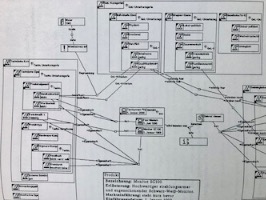Did I mention that I like to make connections? This phrase usually means the ability to discover hidden connections and patterns, usually to gain a better understanding of the world. You can make connections not only in your head, but also outside of it, for example by assembling a model from Lego building blocksIn my case, I actually used Fischertechnik building blocks, with which you could build much more interesting things than with the comparatively boring Legos. But as is so often the case, the profane prevailed and most people now only know the Danish brand., bringing people together as a group, or combining words into a text. The exciting question then is whether what has been brought together works, is fun, and makes sense.
The wonderful feeling when something clicks inside or outside your head, because things unexpectedly fit together or processes suddenly start running, has always driven meIncidentally, this also applies to soccer, when the ball suddenly, as they say, moves by itself.. It is the reason why I listen to complicated pieces of music over and over, ponder over a software architecture for weeks, or edit a text again and again.
I don't remember at what exact age I first read John Brunner's Stand on Zanzibar as a teenager. But the moment Brunner described the special talent of his protagonist Donald Hogan, I wanted to become what he was: a synthesist.
There was one talent Donald Hogan did possess which the majority of the people didn’t: the gift of making right guesses. Some mechanism on the back of his mind seemed ceaselessly to be shifting around factors from the surrounding world, hunting for patterns in them, and when such a pattern arose a silent bell would ring inside his skull.
[… Hogan:] »You’re talking about synthesis, aren’t you?«
»Yes, I’m from the Dilettante Dept—or more officially, from the Office of Research Co-ordination. […] I’ve seen the graphs of your scholastic career, and I get the impression that you could make yourself into a synthesist if you wanted to badly enough, with or without a doctorate.« Dr. Fodan leant back in her chair. […]
Five mornings a week nothing but read, under no compulsion to produce any kind of results—merely requested to mention by mail any association or connection he spottet which he had reason to believe might prove helpful to somebody: advice an astronomer that a market research organisation had a new statistical sampling technique, for instance, or suggest that an entomologist be informed about a new air-pollution problem.
(John Brunner: Stand on Zanzibar, 1968, pp. 49. Siehe auch Synthesist und SFE: Brunner, John)
In this sense, this is intended to become a synthesistic blog. It allows me to »wildly read around« and connect issues, even—or precisely because—I do not have a full understanding of the details. Thus, a good dose of superficial knowledge or even dilettantism will be even helpful.
 Speaking of superficial knowledge: Such has no place in a doctoral thesis that explores a specific topic in depth. Having worn out several doctoral supervisors, with or without a doctorate in the above quote takes on a special meaning for me—but that is another story. A reference to my earlier academic ambitions may be permitted though. The cover photo of this article comes from my diploma thesis ZETTEL — a flexible information system to support creative thinking activities. When I was working on it, so-called hypertext and hypermedia systems were an interesting branch of research. It was investigated whether knowledge could be better represented through a network of associations between texts, data, images, etc. on a computer than through linear presentation in books. That was exactly my thing: building software for the creation of connections.
Speaking of superficial knowledge: Such has no place in a doctoral thesis that explores a specific topic in depth. Having worn out several doctoral supervisors, with or without a doctorate in the above quote takes on a special meaning for me—but that is another story. A reference to my earlier academic ambitions may be permitted though. The cover photo of this article comes from my diploma thesis ZETTEL — a flexible information system to support creative thinking activities. When I was working on it, so-called hypertext and hypermedia systems were an interesting branch of research. It was investigated whether knowledge could be better represented through a network of associations between texts, data, images, etc. on a computer than through linear presentation in books. That was exactly my thing: building software for the creation of connections.
Meanwhile, a guy named Tim Berners-Lee was thinking a little bigger. He wondered how one could connect information, that was distributed in a network of many computers. In 1991, the World Wide Web came into being and changed pretty much everything (https://en.wikipedia.org/wiki/World_Wide_Web). This explains why the first two letters in HTTPS and HTML stand for the word hypertext, and why I express the cross-connections in this blog and elsewhere as references between HTML documents instead of n-ary typed associations of a ZETTEL successor.
Probably for better.
To illustrate, I present one last reference, this one pointing into the realm of music. Just as musicians who can play the piano are called pianists, musicians who primarily use synthesizers are sometimes called synthesists (Synthesist | Electronic Music Wiki | Fandom). As rarely as the word synthesist is used, as a homonym it additionally has the burden to convey two different meanings. Anyway, one day I would like to be a synthesist in both meanings of the word. Working with synthesizers therefore ranks pretty high on my list of projects. Maybe, despite all the inevitable dilettantism, I will be able to make some surprising connections between sound production, programming and scientific findings?

